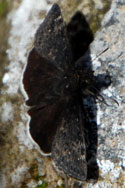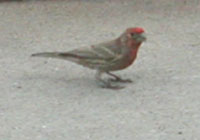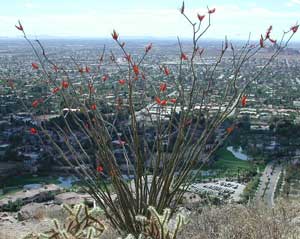Arizonensis --> Sonoran Desert Naturalist --> Sonoran Desert Places --> Estrella Mountain Park --> Estrella Mountain Wilderness
Desert Wild Flower Reports ¦ Field Trip Reports ¦ Birds ¦ Reptiles ¦ Mammals ¦ Cacti ¦ Shrubs and Trees
|
The word ‘estrella’ means star in Spanish and indeed the highest peaks in this range reach for the stars above the low surrounding deserts. The name could also refer to the abundant, sparkling flakes of mica present in the Precambrian schist. The eastern half of the range is part of the Gila River Indian Community and access there is restricted. The northwest quarter of the range lies within Estrella Mtn. Regional Park and is now bordered by housing developments incorporated into the city of Goodyear. The park, exceeding 8000 ha. in size, offers recreation opportunities to a diverse population of outdoor enthusiasts such as picnickers, golfers, equestrians, ball players and mountain bikers. The recent addition of a system of trails designated for mountain biking has greatly reduced the pressure on the horse and pedestrian trails making them more enjoyable. There are over 40 kms of trails ranging through the lower foothills of the Estrellas, but there are no trails into the high country from Estrella Mountain Park. Several kilometers east of the park is Phoenix International Raceway - at times the roaring engine sounds disturb the desert peace. Sponsored LinksFrom Phoenix drive west on I-10 and exit at Estrella Parkway. Turn south and just after crossing the Gila River turn east passing Estrella Golf Course and following signs to park entrance on the south side of the road. There are several hiking trails available. |
View Larger Map. Estrella County Park is indicated by the flagged headquarters house. Blue car is I-10 exit. Trekker symbol is Estrella Wilderness trailhead which is not accessible from the park entrance. Blue balloon to west is Buckeye Hills and yellow balloon to east is South Mountain which are also covered by this website. |
Field Trip Reports:
|

 Painted Lady (left) and Dusky Wing. 
Male House Finch (Carpodacus mexicanus). Females lack red coloring. Sponsored Links |
![]()
BirdsMore frequent towards top of list
|
Sponsored Links
|

|
Side-blotched Lizard (Uta stansburiana) - Photo by Mike Plagens. |
Reptiles
|
|
More common species first ...
|
|
![]()
Shrubs and TreesIn order of Abundance:
|

Ocotillos bloom mostly March to May, but the bright red flowers may also appear at almost any time of year. |
![]()
Legend
Month Name Only : no flowers. no live plants.
 :
usually no or very few blooms open
:
usually no or very few blooms open
 :
a few scattered blooms likely to be seen
:
a few scattered blooms likely to be seen
 :
quite a few blooms likely to be seen, depending on past rainfall
:
quite a few blooms likely to be seen, depending on past rainfall
 :
abundant blooms dependent on favorable rainfall
:
abundant blooms dependent on favorable rainfall
| Common Name | Scientific name | Color | Jan | Feb | Mar | Apr | May | Jun | Jul | Aug | Sep | Oct | Nov | Dec |
| Arch-nutted Comb Bur | Pectocarya recurvata |  |
 |
 |
 |
 |
 |
Jun | Jul | Aug | Sep | Oct |  |
 |
| Bladderpod | Lesquerella sp. |  |
 |
 |
 |
 |
 |
Jun | Jul | Aug | Sep | Oct | Nov |  |
| Brittlebush | Encelia farinosa |   |
 |
 |
 |
 |
 |
 |
 |
 |
 |
 |
 |
 |
| Hairy Bowlesia | Bowlesia incana |  |
 |
 |
 |
 |
 |
Jun | Jul | Aug | Sep | Oct | Nov | Dec |
| Red-stemmed Fillaree | Erodium cicutarium |  |
 |
 |
 |
 |
 |
Jun | Jul | Aug | Sep | Oct |  |
 |
| Texas Filaree | Erodium texanum |  |
 |
 |
 |
 |
 |
Jun | Jul | Aug | Sep | Oct | Nov |  |
| Pelitory | Parietaria hespera |  |
 |
 |
 |
 |
 |
Jun | Jul | Aug | Sep | Oct |  |
 |
| Popcorn Flower | Cryptantha angustifolia |  |
 |
 |
 |
 |
 |
Jun | Jul | Aug | Sep | Oct | Nov |  |
| California Mustard | Guillenia lasiophylla |  / / |
 |
 |
 |
 |
 |
Jun | Jul | Aug | Sep | Oct | Nov |  |
| Orange Fiddleneck | Amsinckia intermedia |  |
 |
 |
 |
 |
 |
 |
Jul | Aug | Sep | Oct | Nov |  |
| Sahara Mustard (weed) | Brassica tournefortii |  |
 |
 |
 |
 |
 |
Jun | Jul | Aug | Sep | Oct | Nov |  |
| Cheese Weed (weed) | Malva Parviflora |  / / |
 |
 |
 |
 |
 |
 |
Jul | Aug | Sep | Oct |  |
 |
| California Poppy | Eschscholzia californica |   |
 |
 |
 |
 |
 |
Jun | Jul | Aug | Sep | Oct | Nov | Dec |
| London Rocket (weed) | Sisymbrium irio |  |
 |
 |
 |
 |
 |
Jun | Jul | Aug | Sep | Oct | Nov |  |
| Lupine | Lupinus sparsiflorus |  |
 |
 |
 |
 |
 |
Jun | Jul | Aug | Sep | Oct | Nov | Dec |
| Desert Globe Mallow | Sphaeralcea ambigua |   |
 |
 |
 |
 |
 |
 |
 |
 |
 |
 |
 |
 |
| Anderson Thornbush;Wolfberry | Lycium andersoni |  / / / / |
 |
 |
 |
 |
 |
 |
 |
 |
 |
 |
 |
 |
| Desert Lavender | Hyptis emoryi |  |
 |
 |
 |
 |
 |
 |
 |
 |
 |
 |
 |
 |
| Purple Three-awn | Aristida purpurea |  |
 |
 |
 |
 |
 |
 |
 |
 |
 |
 |
 |
 |
| Lance-leaf Ditaxis | Argythamnia lanceolata |   |
 |
 |
 |
 |
 |
 |
 |
 |
 |
 |
 |
 |
Page 2
- Estrella Mountain Wilderness
Sonoran Desert Naturalist
Home Page
Desert Places
Field Guide